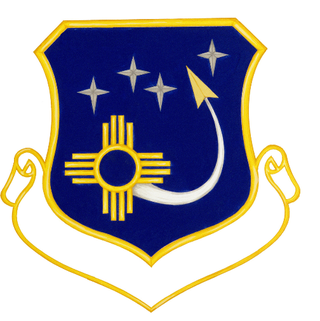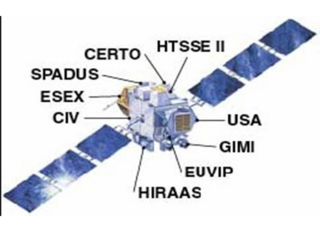
Lew Allen Jr. was a United States Air Force four-star general who served as the tenth Chief of Staff of the United States Air Force. As chief of staff, Allen served as the senior uniformed Air Force officer responsible for the organization, training, and equipping of 750,000 active duty Air Force, Air National Guard, Air Force Reserve, and civilian personnel serving in the United States and overseas. As a member of the Joint Chiefs of Staff, he and the other service chiefs function(ed) as the military advisers to the Secretary of Defense, the National Security Council, and the president.

Ronald "Ron" Michael Sega is an American former astronaut who is professor of systems engineering and Vice President for Energy and the Environment at the Colorado State University Research Foundation, a non-profit advocacy organization supporting CSU. He is also the Vice President and Enterprise Executive for Energy and Environment at Ohio State University. From August 2005 to August 2007, he served as Under Secretary of the Air Force. He is a retired major general in the United States Air Force and a former NASA astronaut. Sega was born in Cleveland, Ohio, he is of Slovene origin. He was married to fellow astronaut Bonnie J. Dunbar. He is now married to Ann Sega and they have two sons. He has lived in both Northfield, Ohio and Colorado Springs.

Kirtland Air Force Base is a United States Air Force base. It is located in the southeast quadrant of the Albuquerque, New Mexico, urban area, adjacent to the Albuquerque International Sunport. The base was named for the early Army aviator Col. Roy C. Kirtland. The military and the international airport share the same runways, making ABQ a joint civil-military airport.

The Air Force Research Laboratory (AFRL) is a scientific research and development detachment of the United States Air Force Materiel Command dedicated to leading the discovery, development, and integration of direct-energy based aerospace warfighting technologies, planning and executing the Air Force science and technology program, and providing warfighting capabilities to United States air, space, and cyberspace forces. It controls the entire Air Force science and technology research budget which was $2.4 billion in 2006.

The Combined Release and Radiation Effects Satellite (CRRES) was launched on July 25, 1990, into a geosynchronous transfer orbit (GTO) for a nominal three-year mission to investigate fields, plasmas, and energetic particles inside the Earth's magnetosphere. As part of the CRRES program, the SPACERAD project, managed by Air Force Geophysics Laboratory, investigated the radiation environment of the inner and outer radiation belts and measured radiation effects on state-of-the-art microelectronics devices.

Rome Laboratory is the US "Air Force 'superlab' for command, control, and communications" research and development and is responsible for planning and executing the USAF science and technology program.

Air Force Materiel Command (AFMC) is a major command (MAJCOM) of the United States Air Force (USAF). AFMC was created on July 1, 1992, through the amalgamation of the former Air Force Logistics Command (AFLC) and the former Air Force Systems Command (AFSC).
TSX-5 is an $85 million satellite successfully launched into orbit on June 7, 2000, from Vandenberg Air Force Base on a Pegasus XL rocket.

The Air Force Nuclear Weapons Center (AFNWC) is a USAF Named Unit, assigned to the Air Force Materiel Command at Kirtland Air Force Base, New Mexico. The AFNWC operates at the Center level of the AFMC. It is currently under the command of Major General John P. Newberry.

Space Systems Command (SSC) is the United States Space Force's space development, acquisition, launch, and logistics field command. It is headquartered at Los Angeles Air Force Base, California and manages the United States' space launch ranges.

Phillips Laboratory was a research and development organization operated by the United States Air Force Materiel Command. In 1997, the Laboratory was merged into the Air Force Research Laboratory as the Space Vehicles and Directed Energy Directorates. It was located at Kirtland Air Force Base in Albuquerque, New Mexico.

The Advanced Research and Global Observation Satellite (ARGOS) was launched on 23 February 1999 carrying nine payloads for research and development missions by nine separate researchers. The mission terminated on 31 July 2003.

The Space Development and Test Wing (SDTW) was a unit of Air Force Space Command's Space and Missile Systems Center of the United States Air Force. The wing is located at Kirtland Air Force Base in Albuquerque, New Mexico.
John Wainwright Evans was an American solar astronomer born in New York City. He spent much of his career studying the sun and working with optics both of which earned him awards. The Evans Solar Facility at Sacramento Peak was named after him. Evans died in a murder–suicide with his wife in 1999.
Dr. Robert E. Huffman (1931–2008) was an American space scientist and author. He specialized in ultraviolet spectroscopy in the earth's upper atmosphere. Working for the United States Air Force, Dr. Huffman managed the Horizon Ultraviolet Program (HUP) experiments on two Space Shuttle flights: Columbia and Discovery.

John Ferdinand "JT" Thompson is a retired lieutenant general in the United States Air Force who last served as the commander of the Space and Missile Systems Center from May 2017 to July 2021. He entered the United States Air Force in 1984 as a graduate of the United States Air Force Academy.

The United States Space Force is organized by different units: the Space Staff, the field commands, and the space deltas.

Timothy A. Sejba is a United States Space Force brigadier general who serves as the commander of Space Training and Readiness Command. He previously served as the program executive officer for both the Space Domain Awareness and Combat Power (SDACP); and Battle Management, Command, Control, and Communications (BMC3) directorates. He has also served as acting director of the Space Rapid Capabilities Office from 2018 to 2019.

Khanh Dai Pham is a Vietnamese-born American aerospace engineer. He is noted for his work in statistical optimal control theory, game-theoretic operations research of military satellite communications, space control autonomy, and space domain awareness and the government leadership in innovation ecosystem and coalition of government agencies, small business and industry. He is a Fellow of the Air Force Research Laboratory (AFRL), the National Academy of Inventors (NAI), the Institution of Engineering and Technology (IET), the Society of Photo-Optical Instrumentation Engineers (SPIE), the Royal Aeronautical Society (RAeS), the International Association for the Advancement of Space Safety (IAASS), and the Royal Astronomical Society (RAS). He is not only a Fellow of the Institute of Electrical and Electronics Engineers (IEEE), the American Astronautical Society (AAS), and the Asia-Pacific Artificial Intelligence Association (AAIA) but also an Associate Fellow of the American Institute of Aeronautics and Astronautics (AIAA) and the Royal Institute of Navigation (RIN).
Margaret Ann ("Peggy") Shea is a space scientist known for research on the connections between cosmic radiation and Earth's magnetic field.















